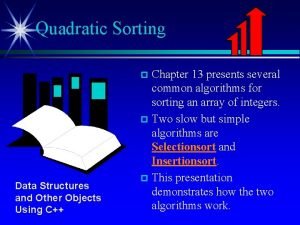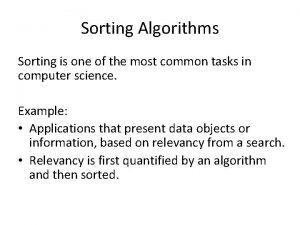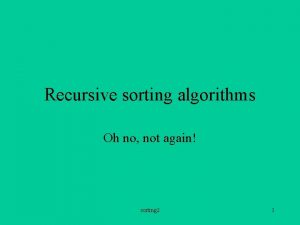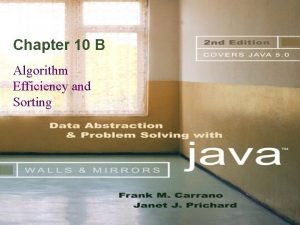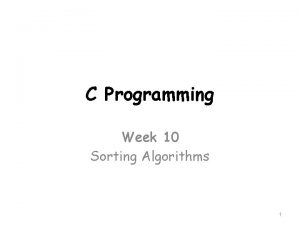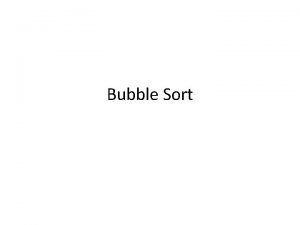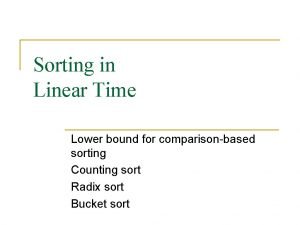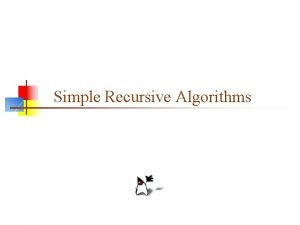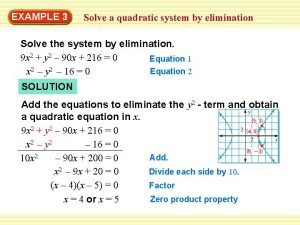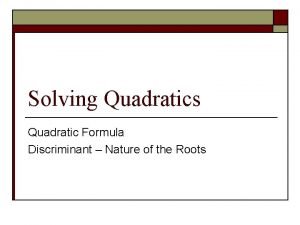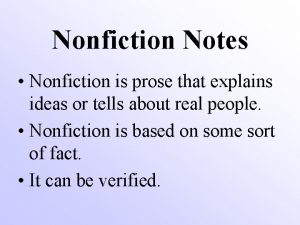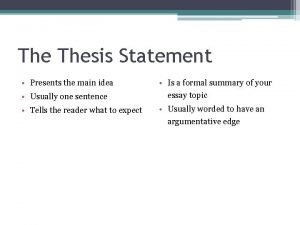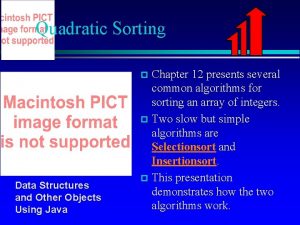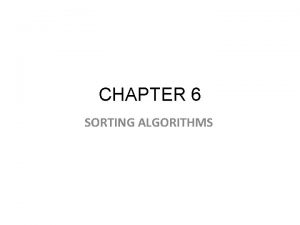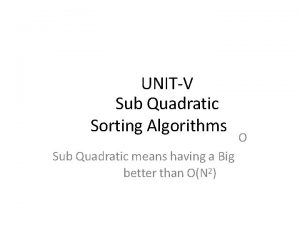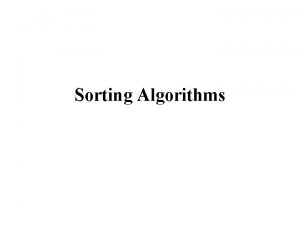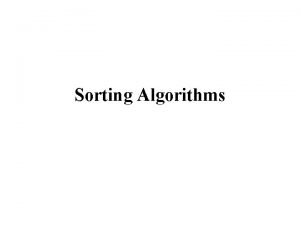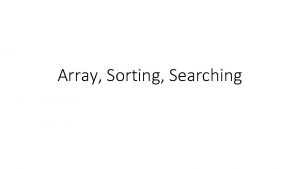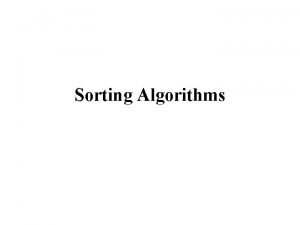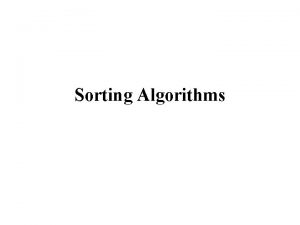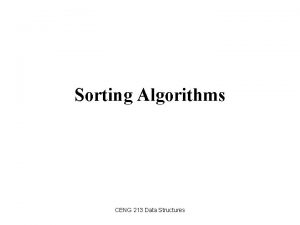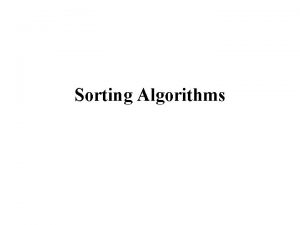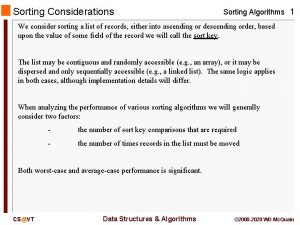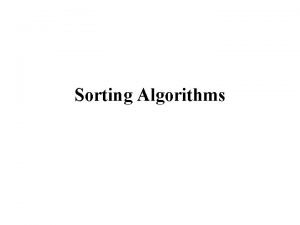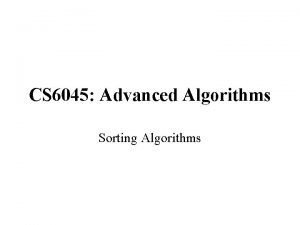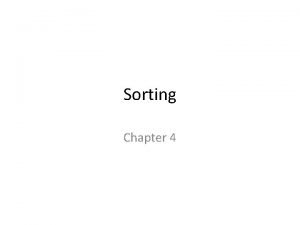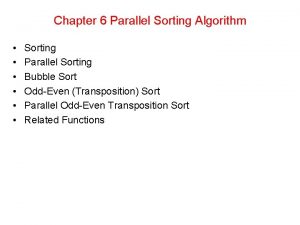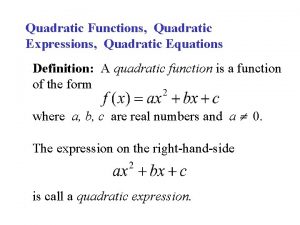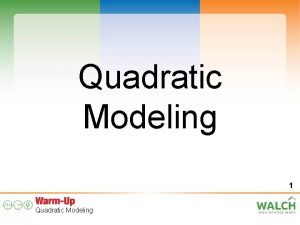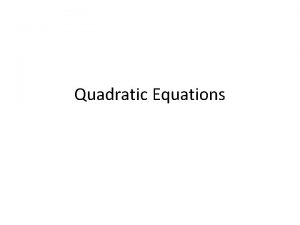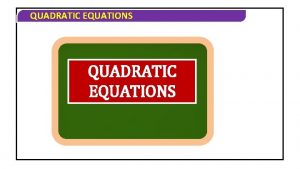Quadratic Sorting Chapter 13 presents several common algorithms


![The Selectionsort Algorithm p Start by finding the smallest entry. [0] [1] [2] [3] The Selectionsort Algorithm p Start by finding the smallest entry. [0] [1] [2] [3]](https://slidetodoc.com/presentation_image/453e5edc63ea42ef6316b6c4e41cfdc6/image-3.jpg)






















![How to Insert One Element · Continue shifting elements. . . [0] [1] [2] How to Insert One Element · Continue shifting elements. . . [0] [1] [2]](https://slidetodoc.com/presentation_image/453e5edc63ea42ef6316b6c4e41cfdc6/image-26.jpg)
![How to Insert One Element · Continue shifting elements. . . [0] [1] [2] How to Insert One Element · Continue shifting elements. . . [0] [1] [2]](https://slidetodoc.com/presentation_image/453e5edc63ea42ef6316b6c4e41cfdc6/image-27.jpg)




![A Quiz p Four items are shifted. [0] [1] [2] [3] [4] [5] A Quiz p Four items are shifted. [0] [1] [2] [3] [4] [5]](https://slidetodoc.com/presentation_image/453e5edc63ea42ef6316b6c4e41cfdc6/image-32.jpg)



- Slides: 35

Quadratic Sorting Chapter 13 presents several common algorithms for sorting an array of integers. p Two slow but simple algorithms are Selectionsort and Insertionsort. p This presentation demonstrates how the two algorithms work. p Data Structures and Other Objects Using C++

Sorting an Array of Integers p The picture shows an array of six integers that we want to sort from smallest to largest [0] [1] [2] [3] [4] [5]
![The Selectionsort Algorithm p Start by finding the smallest entry 0 1 2 3 The Selectionsort Algorithm p Start by finding the smallest entry. [0] [1] [2] [3]](https://slidetodoc.com/presentation_image/453e5edc63ea42ef6316b6c4e41cfdc6/image-3.jpg)
The Selectionsort Algorithm p Start by finding the smallest entry. [0] [1] [2] [3] [4] [5]

The Selectionsort Algorithm Start by finding the smallest entry. p Swap the smallest entry with the first entry. p [0] [1] [2] [3] [4] [5]

The Selectionsort Algorithm Start by finding the smallest entry. p Swap the smallest entry with the first entry. p [0] [1] [2] [3] [4] [5]

The Selectionsort Algorithm Sorted side p Unsorted side Part of the array is now sorted. [0] [1] [2] [3] [4] [5]

The Selectionsort Algorithm Sorted side p Unsorted side Find the smallest element in the unsorted side. [0] [1] [2] [3] [4] [5]

The Selectionsort Algorithm Sorted side Find the smallest element in the unsorted side. p Swap with the front of the unsorted side. Unsorted side p [0] [1] [2] [3] [4] [5]

The Selectionsort Algorithm Sorted side p Unsorted side We have increased the size of the sorted side by one element. [0] [1] [2] [3] [4] [5]

The Selectionsort Algorithm Sorted side p Unsorted side The process continues. . . Smallest from unsorted [0] [1] [2] [3] [4] [5]

The Selectionsort Algorithm Sorted side p The process continues. . . Unsorted side p a S w th wi t n fr o [0] [1] [2] [3] [4] [5]

The Selectionsort Algorithm Sorted side is bigger p Sorted side Unsorted side The process continues. . . [0] [1] [2] [3] [4] [5]

The Selectionsort Algorithm The process keeps adding one more number to the sorted side. p The sorted side has the smallest numbers, arranged from small to large. Sorted side p [0] [1] [2] [3] Unsorted side [4] [5]

The Selectionsort Algorithm p Sorted side We can stop when the unsorted side has just one number, since that number must be the largest number. [0] [1] [2] [3] [4] Unsorted sid [5]

The Selectionsort Algorithm The array is now sorted. p We repeatedly selected the smallest element, and moved this element to the front of the unsorted side. p [0] [1] [2] [3] [4] [5]

The Insertionsort Algorithm p The Insertionsort algorithm also views the array as having a sorted side and an unsorted side. [0] [1] [2] [3] [4] [5]

The Insertionsort Algorithm Sorted side p Unsorted side The sorted side starts with just the first element, which is not necessarily the smallest element. [0] [1] [2] [3] [4] [5]

The Insertionsort Algorithm Sorted side p Unsorted side The sorted side grows by taking the front element from the unsorted side. . . [0] [1] [2] [3] [4] [5]

The Insertionsort Algorithm Sorted side p Unsorted side . . . and inserting it in the place that keeps the sorted side arranged from small to large. [0] [1] [2] [3] [4] [5]

The Insertionsort Algorithm Sorted side p In this example, the new element goes in front of the element that was already in the sorted side. [0] [1] Unsorted side [2] [3] [4] [5]

The Insertionsort Algorithm Sorted side p Unsorted side Sometimes we are lucky and the new inserted item doesn't need to move at all. [0] [1] [2] [3] [4] [5]

The Insertionsort Algorithm Sorted side p Unsorted side Sometimes we are lucky twice in a row. [0] [1] [2] [3] [4] [5]

How to Insert One Element ¶ Copy the new element to a separate location. Sorted side [0] [1] [2] [3] Unsorted side [4] [5]

How to Insert One Element · Shift elements in the sorted side, creating an open space for the new element. [0] [1] [2] [3] [4] [5]

How to Insert One Element · Shift elements in the sorted side, creating an open space for the new element. [0] [1] [2] [3] [4] [5]
![How to Insert One Element Continue shifting elements 0 1 2 How to Insert One Element · Continue shifting elements. . . [0] [1] [2]](https://slidetodoc.com/presentation_image/453e5edc63ea42ef6316b6c4e41cfdc6/image-26.jpg)
How to Insert One Element · Continue shifting elements. . . [0] [1] [2] [3] [4] [5]
![How to Insert One Element Continue shifting elements 0 1 2 How to Insert One Element · Continue shifting elements. . . [0] [1] [2]](https://slidetodoc.com/presentation_image/453e5edc63ea42ef6316b6c4e41cfdc6/image-27.jpg)
How to Insert One Element · Continue shifting elements. . . [0] [1] [2] [3] [4] [5]

How to Insert One Element · . . . until you reach the location for the new element. [0] [1] [2] [3] [4] [5]

How to Insert One Element ¸ Copy the new element back into the array, at the correct location. Sorted side [0] [1] [2] [3] [4] Unsorted sid [5]

How to Insert One Element p Sorted side The last element must also be inserted. Start by copying it. . . [0] [1] [2] [3] [4] Unsorted sid [5]

A Quiz How many shifts will occur before we copy this element back into the array? [0] [1] [2] [3] [4] [5]
![A Quiz p Four items are shifted 0 1 2 3 4 5 A Quiz p Four items are shifted. [0] [1] [2] [3] [4] [5]](https://slidetodoc.com/presentation_image/453e5edc63ea42ef6316b6c4e41cfdc6/image-32.jpg)
A Quiz p Four items are shifted. [0] [1] [2] [3] [4] [5]

A Quiz p Four items are shifted. p. And then the element is copied back into the array. [0] [1] [2] [3] [4] [5]

Timing and Other Issues Both Selectionsort and Insertionsort have a worstcase time of O(n 2), making them impractical for large arrays. p But they are easy to program, easy to debug. p Insertionsort also has good performance when the array is nearly sorted to begin with. p But more sophisticated sorting algorithms are needed when good performance is needed in all cases for large arrays. p

Presentation copyright 2010 Addison Wesley Longman, For use with Data Structures and Other Objects Using C++ by Michael Main. Some artwork in the presentation is used with permission from Presentation Task Force (copyright New Vision Technologies Inc) and Corel Gallery Clipart Catalog (copyright Corel Corporation, 3 G Graphics Inc, Archive Arts, Cartesia Software, Image Club Graphics Inc, One Mile Up Inc, Tech. Pool Studios, Totem Graphics Inc). Students and instructors who use Data Structures and Other Objects Using Java are welcome to use this presentation however they see fit, so long as this copyright notice remains intact. THE END
 Quadratic sorting algorithms
Quadratic sorting algorithms Most common sorting algorithms
Most common sorting algorithms Difference between external and internal sorting
Difference between external and internal sorting Recursive sorting algorithms
Recursive sorting algorithms Efficiency of sorting algorithms
Efficiency of sorting algorithms Sorting algorithms in c
Sorting algorithms in c Complexity of algorithm
Complexity of algorithm Place:sort=8&redirectsmode=2&maxresults=10/
Place:sort=8&redirectsmode=2&maxresults=10/ Bsort
Bsort N
N Introduction to sorting algorithms
Introduction to sorting algorithms Lower bound for comparison based sorting algorithms
Lower bound for comparison based sorting algorithms Simple recursive algorithms.
Simple recursive algorithms. How to solve quadratic equations by elimination
How to solve quadratic equations by elimination Wuadtatic formula
Wuadtatic formula Cause and effect of rain
Cause and effect of rain Presents from my aunts in pakistan poem
Presents from my aunts in pakistan poem Presents from my aunts in pakistan
Presents from my aunts in pakistan Business agility metrics
Business agility metrics 16 3 darwin presents his case answer key
16 3 darwin presents his case answer key Section 15-3 darwin presents his case answers
Section 15-3 darwin presents his case answers Zids and zods
Zids and zods Discussion
Discussion Zids and zods answers
Zids and zods answers Prose writing that presents and explains ideas
Prose writing that presents and explains ideas What is nonfiction prose
What is nonfiction prose Gurmit paid £21 for five presents
Gurmit paid £21 for five presents Nollaig shona meaning
Nollaig shona meaning Quand je t'ouvre mon coeur je te vois seigneur
Quand je t'ouvre mon coeur je te vois seigneur Thesis statement and main idea
Thesis statement and main idea A 26 year old female presents
A 26 year old female presents This presents
This presents A dramatic work that presents the downfall of a character
A dramatic work that presents the downfall of a character Structure of a drama
Structure of a drama The text presents the house with
The text presents the house with Presents simple
Presents simple
